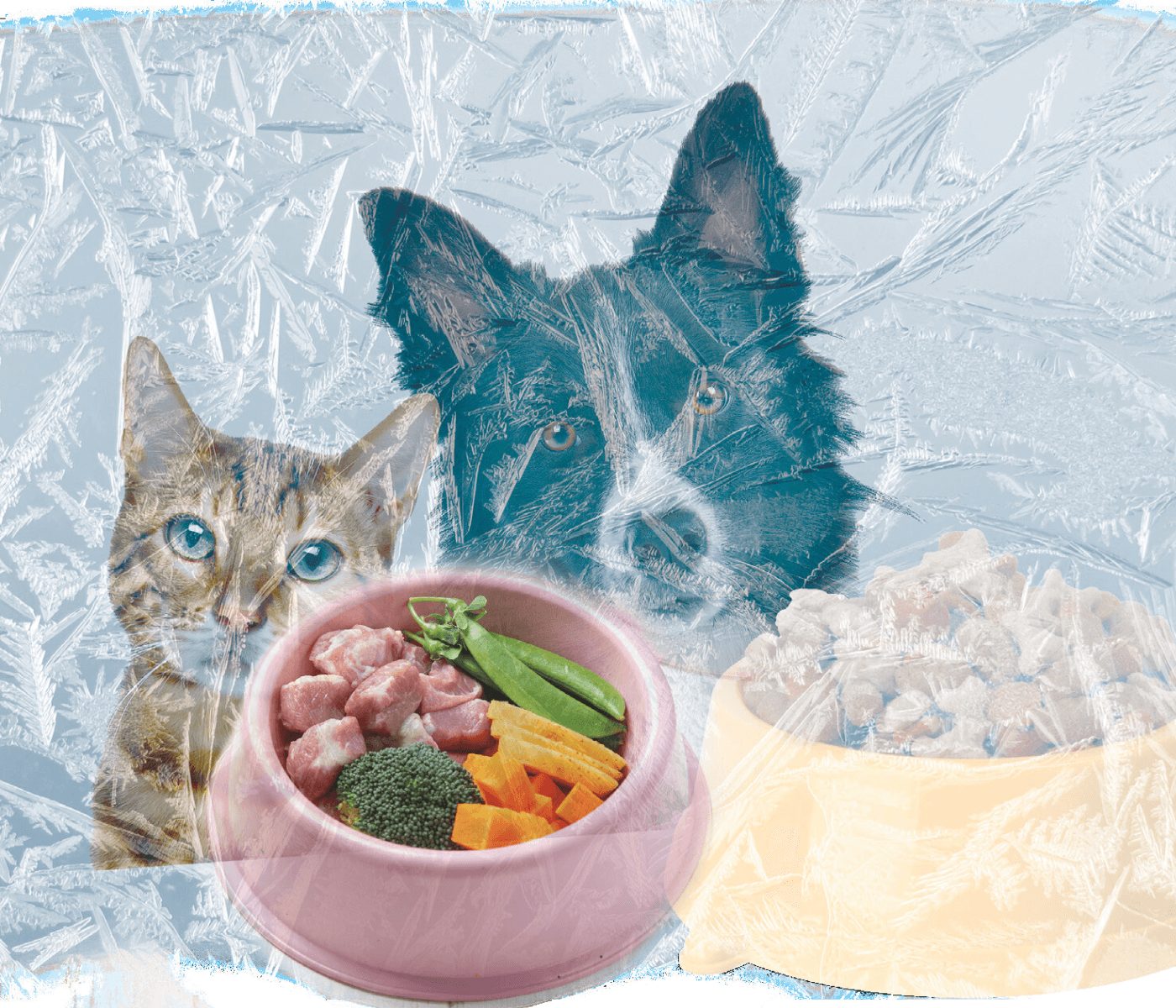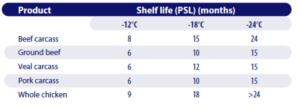Cooling and freezing temperatures are conventional methods widely used to inhibit the growth of microorganisms without the need for synthetic preservatives.
 12 Feb 2024
12 Feb 2024
Ensuring Food Safety in Natural Diets for Dogs and Cats through Freezing
As pet ownership evolves, there’s a growing trend of humanization, extending to their nutritional needs, mirroring developments in human dietary preferences (Viana et al., 2020).
![]() As a consequence, the demand for more natural products and human-grade food ingredients for dogs and cats has significantly grown, resulting in an increased interest in diets commonly referred to as ‘natural diets’.
As a consequence, the demand for more natural products and human-grade food ingredients for dogs and cats has significantly grown, resulting in an increased interest in diets commonly referred to as ‘natural diets’.
 This quest for innovative products has also spurred the need for methods to manufacture and preserve these foods until they reach the shelves, aiming not only to enhance palatability for dogs and cats but also to ensure food safety. Consequently, investment in manufacturing and storage technologies for these foods, alongside adherence to good manufacturing practices (GMP) in facilities, has become crucial to meet the rising market demands.
This quest for innovative products has also spurred the need for methods to manufacture and preserve these foods until they reach the shelves, aiming not only to enhance palatability for dogs and cats but also to ensure food safety. Consequently, investment in manufacturing and storage technologies for these foods, alongside adherence to good manufacturing practices (GMP) in facilities, has become crucial to meet the rising market demands.
| Similar to human food, animal feed is vulnerable to microbiological contamination, particularly when raw diets are involved, which can lead to infections like those caused by Salmonella spp. and Campylobacter spp. (Joffe and Schlesinger, 2002; Bojanić et al., 2017), as well as other bacterial strains (Weese et al., 2005) and parasites (Ahmed et al., 2021). |
Studies on raw diets have revealed that although most animals do not exhibit clinical symptoms, the dissemination of Salmonella spp. can persist in the environment for up to a week (Finley et al., 2007).
![]() As a zoonotic disease, this environmental contamination can lead to disease onset in both animals and immunocompromised humans.
As a zoonotic disease, this environmental contamination can lead to disease onset in both animals and immunocompromised humans.
 Animals can become contaminated by ingesting these potential pathogens in their food. In turn, their guardians can be contaminated through direct contact with the food during its handling, with the contaminated animal, with surfaces and household utensils used for food preparation, or even by ingesting food with cross-contamination (Van Bree et al., 2018). [register]
Animals can become contaminated by ingesting these potential pathogens in their food. In turn, their guardians can be contaminated through direct contact with the food during its handling, with the contaminated animal, with surfaces and household utensils used for food preparation, or even by ingesting food with cross-contamination (Van Bree et al., 2018). [register]
This contamination can result in various diseases, making it a distinct health concern (LeJeune and Hancock, 2001).

Cooling and freezing temperatures are conventional methods widely used to inhibit the growth of microorganisms without the need for synthetic preservatives.
However, the effectiveness of these methods fluctuates depending on the pathogen species, their developmental stage, and the temperature and time parameters (Freeman et al., 2013; Franssen et al., 2019).
 In general, freezing at -21°C for 1-7 days is capable of inactivating parasites in animal origin products, but its reliability in domestic contexts is limited (Franssen et al., 2019).
In general, freezing at -21°C for 1-7 days is capable of inactivating parasites in animal origin products, but its reliability in domestic contexts is limited (Franssen et al., 2019).
FREEZING vs. COOLING OF FRESH FOODS
Utilizing low temperatures, along with good manufacturing practices (GMP), can inhibit the proliferation of microorganisms and chemical and enzymatic reactions (Lopes, 2007), thereby extending the shelf life of foods.
Within the spectrum of food preservation methods lie freezing and cooling. However, it’s crucial to highlight that these are separate processes, and thus, their preservation timelines also differ.
 The cooling process involves temperatures ranging from -1°C to 8°C, preventing ice formation and allowing food storage for 3 to 5 days; however, it does not eradicate microorganisms (Couto and Corte Real, 2019).
The cooling process involves temperatures ranging from -1°C to 8°C, preventing ice formation and allowing food storage for 3 to 5 days; however, it does not eradicate microorganisms (Couto and Corte Real, 2019).

In addition to the mentioned methods, new techniques have been applied to enhance cold temperature preservation, such as the use of vacuum packaging (Zhu, Li, & Sun, 2021).
Freezing food is a common method employed for preservation, aiming to extend shelf life. Fellows (2006) notes that food preservation involves a combination of temperature control, reduction of water activity, and blanching in certain foods. However, factors such as storage methods, packaging, transportation, and handling should also be considered.

![]()
Regarding animal-origin ingredients, meats and their derivatives are typically purchased and stored already frozen, only being thawed at the time of consumption and preparation. The product’s shelf life can vary depending on the storage temperature, as detailed in Table 1.
Table 1. Shelf life of meats (determined by PSL – practical shelf life).

Source: Adapted from Fellows, P.J.
In the case of plant-based foods such as fruits, vegetables, and greens, the recommendation is to consume them within a short period. Freezing slows down microbial growth; however, it’s essential to consider methods that delay the discoloration of these foods, as this visual aspect may be unappealing to pet owners.
Primo et al. (2018) examined how blanching and immersion in citric acid affected the freezing of fruits and vegetables, such as apples, bananas, pears, broccoli, and potatoes. Their findings indicated that the use of citric acid assisted in slowing down discoloration.
However, in addition to temperature, other factors (obstacles) should also be considered to prevent the growth of undesirable microorganisms and enhance the safety and durability of foods.
These “obstacles” may include factors such as:

Generally, low temperatures reduce or even halt microbial growth. However, it’s essential to understand the microbial growth range for each food item individually.
The bacterial microorganisms classified as psychrotrophic are particularly concerning because they grow even in refrigeration at 7°C.
Thus, studies underscore the significance of temperature selection when storing food and its influence on its quality (Jay, 2005).
![]() For example, bananas are best preserved when stored at 13°C, whereas most vegetables and potatoes have an optimal storage temperature of 10°C
For example, bananas are best preserved when stored at 13°C, whereas most vegetables and potatoes have an optimal storage temperature of 10°C
It is crucial to respect the freezing point of each type of food.

For example, vegetables, with a water content of 78-92%, have a freezing point ranging from -0.8°C to -2.8°C, while fruits, with 87-95% water, freeze at temperatures between -0.9°C and -2.7°C. On the other hand, meat, with a water content of 55-70%, freezes at temperatures between -1.7°C and -2.2°C (Fellows, 2006).
Additionally, it is important to consider the relative humidity of the environment, as foods can absorb water from the surroundings, especially when the water activity is equal to 0.6 (Jay, 2005).
EFFECT OF WATER ACTIVITY ON FOODS
Among the numerous factors associated with microbial growth in foods, water activity emerges as the most significant. Water activity refers to the available free water for the proliferation of pathogenic microorganisms.
Figure 1 (Fennema, 2000) depicts the relative deterioration rate concerning water activity, indicating that bacterial growth initiates around 0.9. Nevertheless, mold growth and enzymatic activity precede this threshold.
Hence, the optimal range of water activity in foods typically falls between 0.4 and 0.6, as lipid oxidation compounds are already evident below 0.3.

Figure 1. Adapted from Fennema, 2000
 Moist foods, like frozen ones, may not inherently possess a high water activity. However, the majority of fresh foods typically exhibit a water activity exceeding 0.99 (Jay, 2005). Thus, storage practices must be implemented to manage microbial growth and ensure the safety of these foods.
Moist foods, like frozen ones, may not inherently possess a high water activity. However, the majority of fresh foods typically exhibit a water activity exceeding 0.99 (Jay, 2005). Thus, storage practices must be implemented to manage microbial growth and ensure the safety of these foods.
FINAL CONSIDERATIONS
![]() The use of freezing for food preservation is an effective technique to extend their shelf life, ensuring greater safety for the health of dogs and cats fed diets containing human-grade ingredients.
The use of freezing for food preservation is an effective technique to extend their shelf life, ensuring greater safety for the health of dogs and cats fed diets containing human-grade ingredients.
![]() However, to guarantee the efficacy of this approach, it’s crucial to supplement it with good manufacturing practices (GMP) and appropriate packaging, transportation, and storage.
However, to guarantee the efficacy of this approach, it’s crucial to supplement it with good manufacturing practices (GMP) and appropriate packaging, transportation, and storage.
![]() Therefore, it is feasible to safely produce and market diets considered “natural”.
Therefore, it is feasible to safely produce and market diets considered “natural”.
References available upon request. [/register]
Subscribe now to the technical magazine of animal nutrition
AUTHORS

Nutritional Interventions to Improve Fertility in Male Broiler Breeders
Edgar Oviedo
The Use of Organic Acids in Poultry: A Natural Path to Health and Productivity
M. Naeem
Synergistic Benefits of Prebiotics and Probiotics in Poultry, Swine, and Cattle
Gustavo Adolfo Quintana-Ospina
Hybrid Rye Potential in Laying Hen Feed Rations
Gwendolyn Jones
A day in the life of phosphorus in pigs: Part I
Rafael Duran Giménez-Rico
Use of enzymes in diets for ruminants
Braulio de la Calle Campos
Minerals and Hoof Health in the Pregnant Sow
Juan Gabriel Espino
Impact of Oxidized Fats on Swine Reproduction and Offspring
Maria Alejandra Perez Alvarado